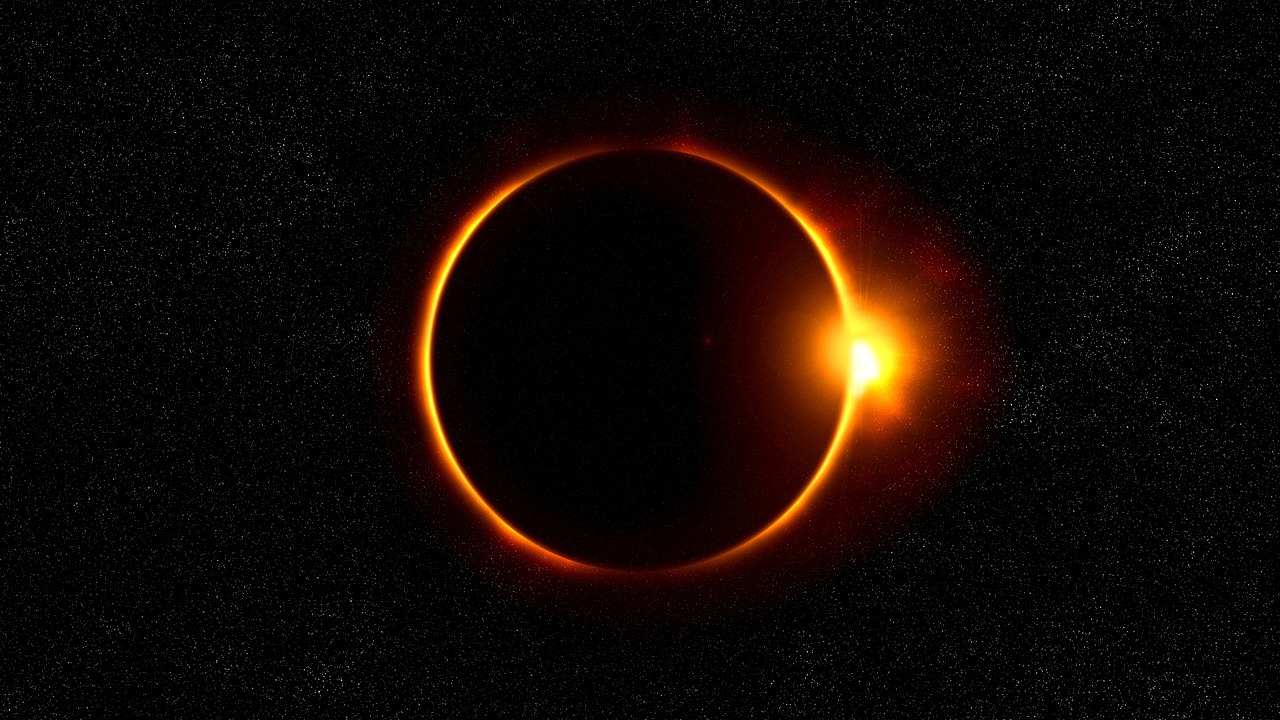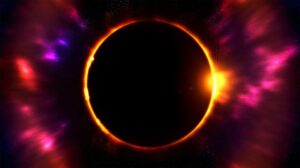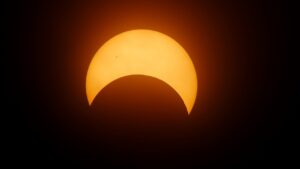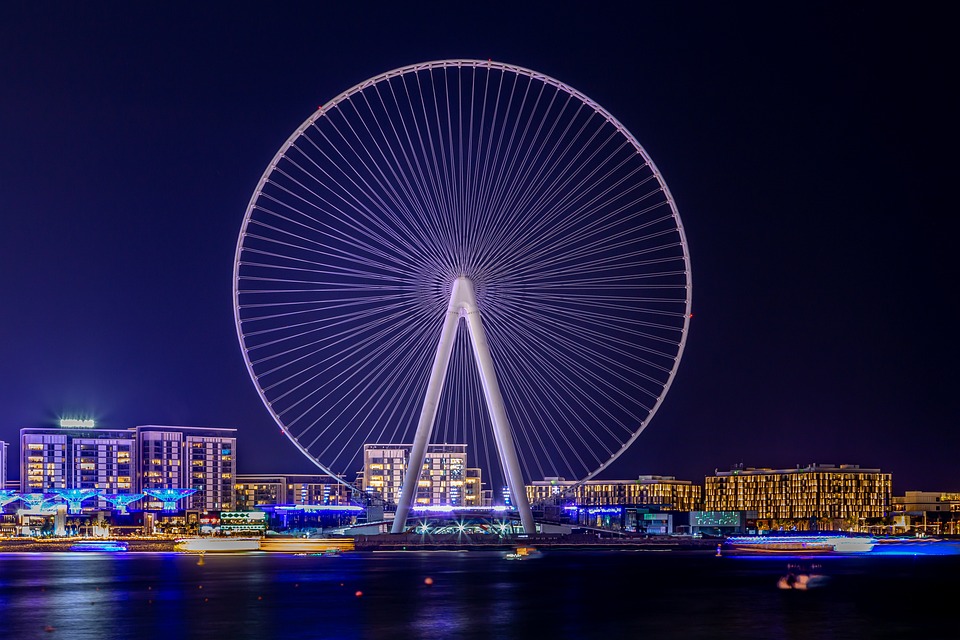
Solar Eclipse Total On 2024 April 8
Solar Eclipse When the Moon comes between the Earth and the Sun during its transit, the Sun becomes partially or completely invisible to an observer on Earth. This event is called a Central eclipse. This happens when the new moon rises after the new moon. At least two to five solar eclipses are observed on Earth every year. Between zero and two solar eclipses are total solar eclipses.
Solar Eclipse:
When the Moon comes right between the Sun and the Earth as it orbits the Earth, it blocks the Sun’s light from reaching the Earth—that is, the Moon’s shadow falls on parts of the Earth. This event is called a Central eclipse. At this time the sun, moon, and earth are in the same straight line. Solar eclipses can be of different types; Such as partial, total, annular and hybrid eclipses.
How the sun is eclipsed even though the sun is bigger:
You may be wondering, the diameter of the sun is 400 times larger than the diameter of the moon, how can the moon completely cover the sun? The reason is simple, although the Moon is smaller than the Sun, it is 400 times closer to the Earth, so the Moon and the Sun appear almost identical from Earth’s surface. The Moon’s orbit is slightly elliptical, when it is closest to the Earth, the distance from the Moon to the Earth is 3.63 lakh km, when it is farthest from the Earth, the distance from the Moon to the Earth is 4.05 lakh km. Apogee refers to the moon’s farthest distance from Earth, whereas perigee denotes the moon’s minimum distance from Earth.

Partial Solar Eclipse:
A partial Central eclipse occurs when the Moon covers a small part of the Sun between the Earth and the Sun. In this case, where a partial Central eclipse is observed, the sun is seen partially covered by the moon. During a partial solar eclipse, the penumbra is mainly dominant.
Total solar eclipse:
A total Central eclipse occurs if the Moon completely covers the Sun during an eclipse. As we know, the moon orbits the Earth in an elliptical path. As a result, sometimes when the moon is close to the Earth (Anubhu), the moon appears relatively large. If a Central eclipse occurs when the moon is horizontal, it is a total Central eclipse. At such times, a total Central eclipse can be seen from all the places where the shadow falls.
How does a total solar eclipse occur?
During a total Central eclipse, its corona is seen around the Sun. Only at this time is it possible to see the sun’s corona with the naked eye, which is lucky to see at other times, the rays cover only a small part, and the earth also rotates on its axis. As a result, the ray does not stay at a fixed place, it moves along a line on the Earth’s surface (which we call the ecliptic). Everywhere on Earth’s surface where this line falls is able to see a total solar eclipse. A total Central eclipse is named after the section of the sun that seems to be a diamond ring when it is completely covered at the beginning of the eclipse and a tiny portion of it remains visible after the whole cover.
Annular Solar Eclipse:
Sometimes the Moon is in such a position while traveling in its elliptical path that it cannot completely cover the Sun during a total Central eclipse. Next, the moon appears to have a ring around the sun. One term for such an event is an annular Central eclipse.
A lunar eclipse happened a few days ago. Lunar eclipse occurs on Dolapurnima day. Earthlings are going to witness a rare cosmic sight next week. This solar eclipse is going to happen on April 8.
However, Bangladesh and India will not be seeing this adoption. The eclipse will be visible only in the region from Mexico to Canada. The whole world is eagerly waiting to see this cosmic spectacle.

From where is it visible?
On April 8, between 9:43 PM and 2:52 AM Bangladesh time, there will be a solar eclipse. It is hence invisible from Bangladesh, India, and the neighboring regions. There are locations in the United States, Mexico, and Canada where people may see this eclipse. According to astronomers, a partial solar eclipse will be visible from Iceland, Colombia, Venezuela, Spain, Britain, Ireland, and Portugal, in addition to several locations in the Caribbean.
When will it be approved?
According to NASA, the United States space agency, the total Central eclipse will last from 1 to 4 and a half minutes. The eclipse will be visible for the longest time in Texas, USA, where it will be visible for 4 minutes and 27 seconds as a total Central eclipse. At that time the moon will completely cover the sun. As a result, darkness will descend during the day.
How others will see?
Bangladesh, India, and the surrounding areas won’t be able to witness the eclipse, but you can view it all directly from NASA’s website. As a result, people interested in viewing the solar eclipse can easily watch the total Central eclipse live online through their smartphones or computers. There will be two partial solar eclipses this year, according to astronomers.
Why is it so important?
Astronomers say this Central eclipse is going to be rare. They said, the world is going to witness a cosmic scene! Because, after 50 years there is going to be a total Central eclipse. This eclipse will be the longest in US history since 1806. According to scientists, the last time this long total eclipse happened was in 1973. We will have to wait many more years to see such a scene again.
Solar Eclipse 2024: During the early part of the second week of April, there will be a Central eclipse. This year’s eclipse duration will be the longest in 50 years. There will be a Central eclipse on April 8 that lasts for four hours and twenty-five minutes. Once more, darkness will envelop the whole planet for seven and a half minutes. The timing of this adoption has left Americans in a quandary. Apart from this, there are many questions about the first Central eclipse of the year in the minds of Indians. Let’s find out what astrology has to say about the April 8 Central eclipse.

Date and time of solar eclipse:
This year there will be a central eclipse on April 8. This eclipse will be seen in America, Mexico, Canada, Ireland, and England. The reception will start at 2:00 pm.
The reception will start on April 8 at 9:12 PM IST. In other words, India will not see this adoption. Khandgras will start at 10:10 PM and end at 2:22 AM.
Will the Sutak time be valid?
According to astrology, when the Central eclipse begins, it will be night in India. So here this eclipse will be invisible. No sutak kaala will be valid due to the non-observation of the Central eclipse.
Although not seen in India, the adoption will have ramifications in many areas
Due to the non-observance of this eclipse in India, the Sutak calendar will not be valid. But India’s future is not entirely free from the effects of this eclipse. According to astrological calculations, there will be Central eclipse effects in India and other countries for the next 6 months. The first Central eclipse of the year is raising the possibility of emergency in many countries including India.
5 adoptions within the next one year:
Astrological studies indicate that between April 2024 and April 2025, five solar eclipses and one lunar eclipse will occur in India. On September 18, there will be a second lunar eclipse after this one. India will not be able to see this moon eclipse. So it doesn’t have to follow any sutak kaal.
Chaitra Navratri will begin
Vikram Sambat begins on April 9, the day after the Central eclipse on April 8. Chaitra Navratri begins from this day.
Effects and Significance of Solar Eclipse:
A Central eclipse has temporary effects on the environment. While a total solar eclipse only covers the sun for a few minutes, a partial eclipse may linger for a very long period. The unexpected darkness during full feeding startles the animals. Untimely darkness causes many birds to stop calling, rattlesnakes may start chirping, plants may begin to wilt. Air temperature may drop slightly in some places.
Solar eclipses Solar research:
Solar eclipses create some rare opportunities for solar research. For example, the best opportunity to gather information about the Sun’s corona comes during a solar eclipse. Because the Moon protects it and the Sun’s corona is separate from Earth’s atmosphere, it is visible from the planet’s surface. During an eclipse, one may see the Earth’s atmosphere, particularly the high atmosphere. The outermost layer of the Earth’s atmosphere produces a variety of charged particles due to solar radiation. This part of the Earth is home to many artificial satellites and it is very important to observe it.
Solar Eclipse Observations & Alerts:
One thing to always remember is that many harmful rays from the sun reach the earth, one of which is ultraviolet rays. Since we cannot see UV rays, looking at them without knowing it can cause serious eye damage. Looking directly at the sun can cause permanent eye damage in just a few seconds. The safest way to observe a solar eclipse is not to look directly at the sun, but to reflect the sun somewhere. A solar eclipse is easy to observe using a pinhole, a small hole in a piece of cardboard that reflects sunlight onto another screen during the eclipse.
If you learn more about solar eclipse visit the website




